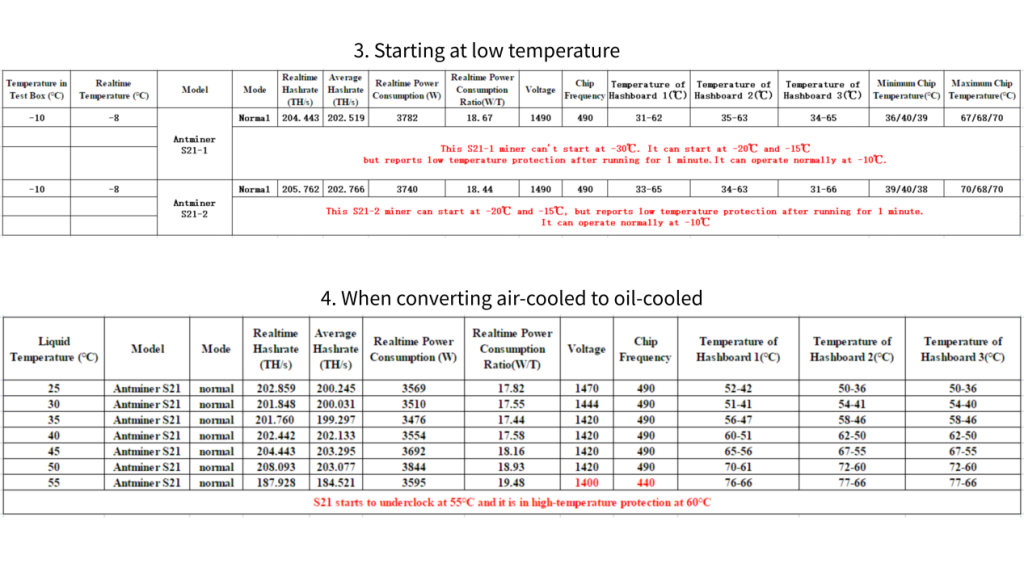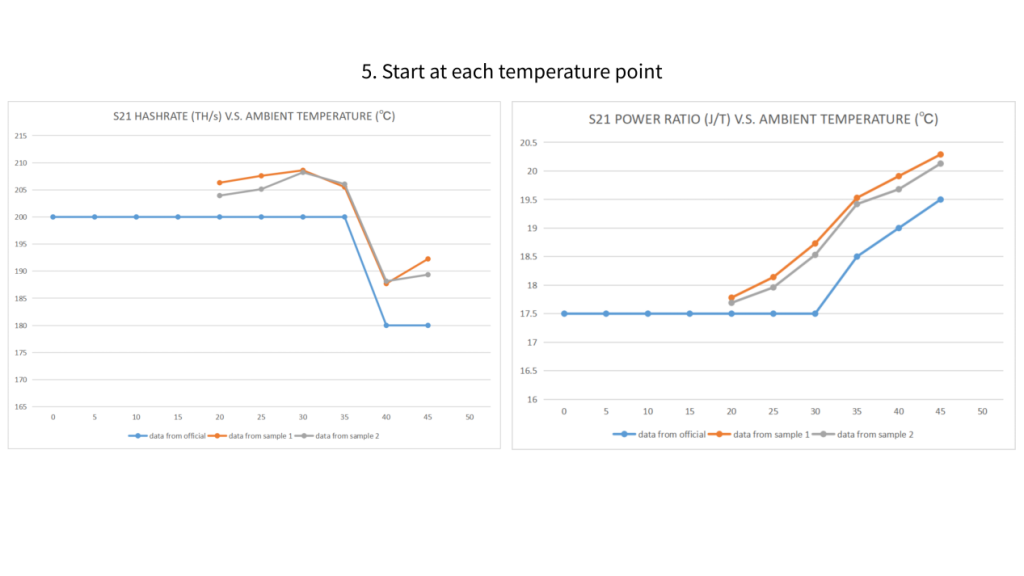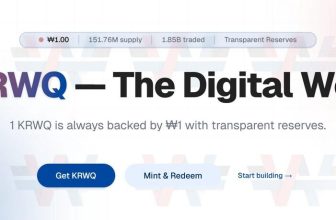
In our Antminer S21 review, we tested S21’s hashrate and efficiency at a range of different temperatures and when it was converted to oil-cooled to test its real performance.
S21 is the latest generation of ASIC miner launched by Bitmain in 2023 with the SHA256 algorithm. It can currently mine BTC/BCH/BSV. S21 specification is disclosed by Bitmain official with hashrate 200T and power efficiency 17.5J/T. Bitmain also shows the impact of temperature on hash rate and power consumption ratio on the website. Seems like S21 is the most efficient Asic miner so far, therefore we did two samples to test the real performance.
About S21 testing data
- At ambient temperature

2. At heat tolerance temperature
The S21’s tolerance temperature is 48℃. When the ambient temperature surpasses 40℃, the hash board will activate over-temperature protection, resulting in a underclocking of the chip. The frequency will be reduced from 490M to 440M. If the temperature exceeds 47℃, the S21 miner will automatically shut down as a safety precaution.
3. Starting at low temperature
S21 can start and operate effectively at -10℃. While it starts normally at -20℃ and -15℃, the system will activate low temperature protection and shut down the miner. Therefore, the S21 requires a higher initial temperature compared to the S19XP.

4. When converting air-cooled to oil-cooled
Oil-cooled version has improved the unit power density compared with air-cooled, but when air-cooled is converted to oil-cooled, it also faces warranty issues and has less advantages than specific immersion-cooled miners. When S21 converts air-cooled to oil-cooled, the power consumption ratio is higher than 18.5W/T at 50℃, starts to underclock at 55℃, and it is in high-temperature protection at 60℃.
5. Start at each temperature point
The power consumption ratio experiences an approximate increase of 1.74W/T when the hashrate reaches 200T within the temperature range of 20℃ to 35℃. At 40℃, a reduction in the frequency of the S21 occurs, resulting in an operating frequency below 440M and a hash rate of 180T. Furthermore, at 45℃, the power consumption ratio increases by approximately 2.4W/T. Once the temperature exceeds 45℃, protection mode is initiated, leading to a rapid rise in the power consumption ratio.

It has come to our attention that when two S21 air-cooling miners are operating at temperatures of 25℃ and above, their power consumption ratio significantly exceeds the official specifications provided by the manufacturer. Furthermore, the hash rate demonstrates substantial fluctuations under high-temperature conditions. Under some extreme temperatures or harsh environmental conditions, the S21 fails to achieve the specified power consumption ratio it claimed and loses its competitive advantage in the market.
DISCLAIMER: CAPTAINALTCOIN DOES NOT ENDORSE INVESTING IN ANY PROJECT MENTIONED IN SPONSORED ARTICLES. EXERCISE CAUTION AND DO THOROUGH RESEARCH BEFORE INVESTING YOUR MONEY. CaptainAltcoin takes no responsibility for its accuracy or quality. This content was not written by CaptainAltcoin’s team. We strongly advise readers to do their own thorough research before interacting with any featured companies. The information provided is not financial or legal advice. Neither CaptainAltcoin nor any third party recommends buying or selling any financial products. Investing in crypto assets is high-risk; consider the potential for loss. Any investment decisions made based on this content are at the sole risk of the readCaptainAltcoin is not liable for any damages or losses from using or relying on this content.








